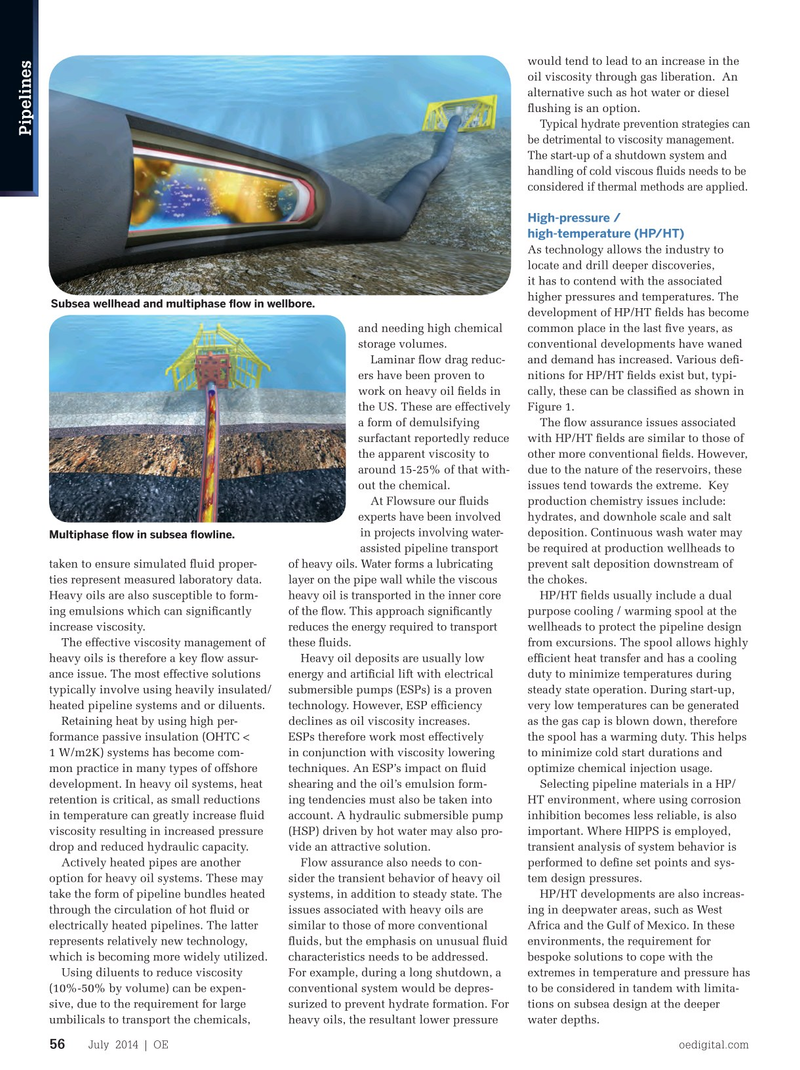
Page 54: of Offshore Engineer Magazine (Jul/Aug 2014)
Read this page in Pdf, Flash or Html5 edition of Jul/Aug 2014 Offshore Engineer Magazine
would tend to lead to an increase in the oil viscosity through gas liberation. An alternative such as hot water or diesel fushing is an option.
Typical hydrate prevention strategies can
Pipelines be detrimental to viscosity management.
The start-up of a shutdown system and handling of cold viscous fuids needs to be considered if thermal methods are applied.
High-pressure / high-temperature (HP/HT)
As technology allows the industry to locate and drill deeper discoveries, it has to contend with the associated higher pressures and temperatures. The
Subsea wellhead and multiphase fow in wellbore. development of HP/HT felds has become and needing high chemical common place in the last fve years, as storage volumes. conventional developments have waned
Laminar fow drag reduc- and demand has increased. Various def- ers have been proven to nitions for HP/HT felds exist but, typi- work on heavy oil felds in cally, these can be classifed as shown in the US. These are effectively Figure 1.
a form of demulsifying The fow assurance issues associated surfactant reportedly reduce with HP/HT felds are similar to those of the apparent viscosity to other more conventional felds. However, around 15-25% of that with- due to the nature of the reservoirs, these out the chemical. issues tend towards the extreme. Key
At Flowsure our fuids production chemistry issues include: experts have been involved hydrates, and downhole scale and salt in projects involving water- deposition. Continuous wash water may
Multiphase fow in subsea fowline.
assisted pipeline transport be required at production wellheads to taken to ensure simulated fuid proper- of heavy oils. Water forms a lubricating prevent salt deposition downstream of ties represent measured laboratory data. layer on the pipe wall while the viscous the chokes.
Heavy oils are also susceptible to form- heavy oil is transported in the inner core HP/HT felds usually include a dual ing emulsions which can signifcantly of the fow. This approach signifcantly purpose cooling / warming spool at the increase viscosity. reduces the energy required to transport wellheads to protect the pipeline design
The effective viscosity management of these fuids. from excursions. The spool allows highly heavy oils is therefore a key fow assur- Heavy oil deposits are usually low effcient heat transfer and has a cooling ance issue. The most effective solutions energy and artifcial lift with electrical duty to minimize temperatures during typically involve using heavily insulated/ submersible pumps (ESPs) is a proven steady state operation. During start-up, heated pipeline systems and or diluents. technology. However, ESP effciency very low temperatures can be generated
Retaining heat by using high per- declines as oil viscosity increases. as the gas cap is blown down, therefore formance passive insulation (OHTC < ESPs therefore work most effectively the spool has a warming duty. This helps 1 W/m2K) systems has become com- in conjunction with viscosity lowering to minimize cold start durations and mon practice in many types of offshore techniques. An ESP’s impact on fuid optimize chemical injection usage. development. In heavy oil systems, heat shearing and the oil’s emulsion form- Selecting pipeline materials in a HP/ retention is critical, as small reductions ing tendencies must also be taken into HT environment, where using corrosion in temperature can greatly increase fuid account. A hydraulic submersible pump inhibition becomes less reliable, is also viscosity resulting in increased pressure (HSP) driven by hot water may also pro- important. Where HIPPS is employed, drop and reduced hydraulic capacity. vide an attractive solution. transient analysis of system behavior is
Actively heated pipes are another Flow assurance also needs to con- performed to defne set points and sys- option for heavy oil systems. These may sider the transient behavior of heavy oil tem design pressures.
take the form of pipeline bundles heated systems, in addition to steady state. The HP/HT developments are also increas- through the circulation of hot fuid or issues associated with heavy oils are ing in deepwater areas, such as West electrically heated pipelines. The latter similar to those of more conventional Africa and the Gulf of Mexico. In these represents relatively new technology, fuids, but the emphasis on unusual fuid environments, the requirement for which is becoming more widely utilized. characteristics needs to be addressed. bespoke solutions to cope with the
Using diluents to reduce viscosity For example, during a long shutdown, a extremes in temperature and pressure has (10%-50% by volume) can be expen- conventional system would be depres- to be considered in tandem with limita- sive, due to the requirement for large surized to prevent hydrate formation. For tions on subsea design at the deeper umbilicals to transport the chemicals, heavy oils, the resultant lower pressure water depths.
July 2014 | OE oedigital.com 56 054_OE0714_Pipelines-3.indd 56 6/20/14 7:14 PM

 53
53

 55
55